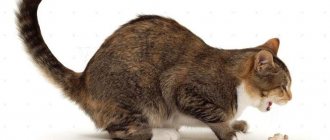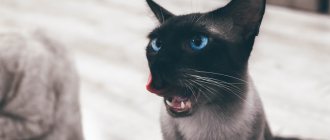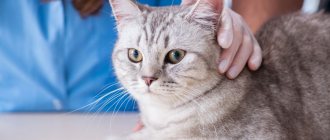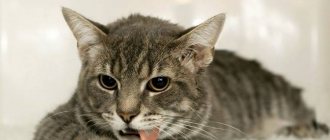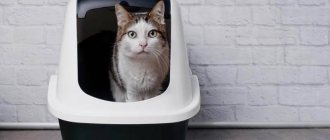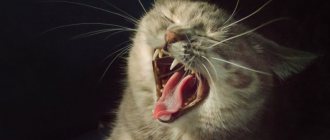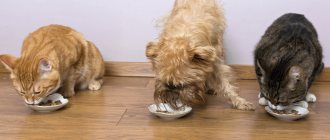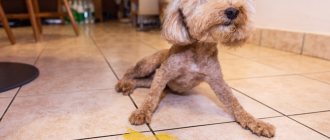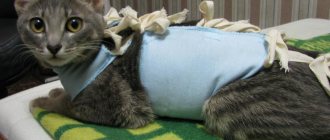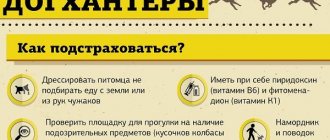19775Pavel
5
Sometimes cat owners notice that their pet begins to feel sick after eating both commercial and natural food. There are many reasons why a cat vomits after eating undigested food. And the most harmless one is overeating. Murka could simply overeat and in this way empty her stomach. Vomiting of pieces of unprocessed food can also occur if the animal has been starving for a long time. The stomach may simply not be ready to receive a significant amount of food.
But a cat’s vomiting after eating can also occur for more serious reasons. For example, a pet vomits pieces of food in the presence of chronic gastrointestinal pathology.
In any case, if a cat burps after eating for no apparent reason, then he needs a full medical examination. The veterinarian will be able to determine why the animal is vomiting after eating, and also prescribe treatment appropriate to the current condition.
© shutterstock
What causes vomiting
In the case of a one-time incident, we can talk about non-dangerous physiological causes of nausea. If vomiting occurs repeatedly, you need to consult a veterinarian.
Non-hazardous reasons
Most often, vomiting in animals occurs after overeating and when the cat absorbs its food too quickly. For example, if several animals live and feed together, they begin to compete for food and try to eat as much as possible, swallowing food in pieces. But the digestive tract cannot accommodate such a volume and pushes food back.
Vomiting can also occur when consuming low-quality feed with low protein content. Cheap products contain only three percent meat. If the amount of complete protein is insufficient, the number of enzymes produced decreases, food is not digested, and the cat cleanses the digestive tract by vomiting. By-products and additives included in cheap feeds also provoke vomiting.
If after a single vomiting the pet’s condition is normal, he does not have a fever, he is cheerful, happy, with a wet nose and shiny eyes, he eats and plays again, then everything is fine - there is no need to worry. The animal is healthy and most likely the problem was overeating.
Causes requiring treatment
Poisoning is a fairly common cause of vomiting in cats. A cat can become poisoned by poor-quality food or inedible substances. In this case, the animal’s body cleanses itself of the remnants of poor-quality food and toxins through vomiting. In addition, loose stools are observed, which promotes rapid cleansing of the intestines.
Diseases that cause vomiting in a cat after eating and not only include:
- bacterial and viral infections are the most dangerous group, as they often lead to death;
- inflammatory processes in the stomach, pancreas, intestines, tumors and ulcers;
- presence of parasites.
If vomiting recurs and the cat’s well-being worsens, if blood and mucus can be seen in the vomit, then it is necessary to show the animal to a veterinarian. The doctor will find the reasons why your cat vomits after eating and prescribe the optimal treatment.
Prevention
So, we have looked at why a cat may vomit food after eating, now we will look at how to prevent this.
The most important thing is to comply with the basic rules for keeping animals:
- Cats require regular treatment for worms, regardless of whether they are indoors or have access to the street - parasite eggs can be brought into the house from the street!
- It is very important to feed cats correctly; the so-called table food will sooner or later lead to illness in your pet! If you do not want to feed your cat industrial food, we recommend contacting nutritionists to create a balanced menu.
- To prevent hair vomiting and the formation of mats, do not forget to brush your cats regularly, especially during the shedding period.
- Preventive vaccination will protect your pets from many viral diseases that a cat can catch even while sitting at home.
- It is also important to exclude the possibility of poisoning from household chemicals and poisonous plants!
What can vomiting look like after eating?
Vomiting after eating is not always a disease; it can be a sign of a one-time cleansing for physiological reasons. By its appearance and consistency, you can determine the reason that caused the stomach to reject food. If a cat vomits after eating undigested food, it is necessary to examine the vomit and, if any signs are suspicious, contact a veterinarian.
Undigested food
If a cat vomits after eating undigested food, this means that the pet was overfed or he ate too quickly. The stomach is unable to process large pieces that are swallowed greedily, which is where problems arise.
Owners should take into account that a single case of vomiting does not pose a threat to the health of the animal, however, if it occurs repeatedly, it is necessary to make an appointment with a doctor. One of the reasons for constant vomiting of undigested food may be a malfunction of the pancreas or problems with the stomach itself.
With hairballs
Cat breeds with long, thick hair may well suffer from hairball vomiting (trichobezoars). While licking, the pet swallows fur, it accumulates in the stomach and causes discomfort. Large hairballs irritate the mucous membranes of the stomach walls, the so-called tickling. Trichobezoars interfere with normal digestion of food and, as a result, cause vomiting.
If wool is constantly swallowed by an animal, it clogs the stomach or intestines itself - this requires urgent treatment, as it can be fatal. Special pastes or herbs will help prevent trouble - when eating it, the cat feels nauseous. Vomiting removes the fur from the body, and it continues to function normally.
With bile or foam
Sometimes a cat vomits after eating with bile or foam. It is necessary to distinguish between these two options.
If you vomit with bile, you may suspect problems with the gallbladder or liver function. In exceptional cases, vomit may have traces of white foam. There is no need to waste time, but urgently take the cat to the hospital - he is in pain, unwell, and without treatment he may die.
Vomiting with white foam most often symbolizes that the cat is hungry. If an animal has not eaten for a long time and then swallows a large amount of food, there is a high probability of nausea from undigested food covered in white foam.
In case of regular repetitions of foamy or yellow vomiting, it is necessary to take the cat to the doctor and have it examined.
How to feed a cat correctly
A pet will not drink vitamins if they are lacking, so all the vitamins and minerals it needs must be present in the food. The animal needs balanced food. How to feed your furry friend correctly, how to make sure that the animal receives with food everything it needs for proper development and good health?
- First, the amount of food should be limited. You need to feed the animal 2-3 times, in the morning and in the evening, but you can skip lunch. Portions should be approximately the same size each time. It is better to put in less food and then add it later, rather than the animal overeating and becoming ill.
- Thirdly, the water in the bowl must be clean. You need to change and add water at least twice a day, it is better to do this in the morning and evening. Your furry friend should always have water. There is no need to experiment and pour mineral water with gases into your cat. The cat will not drink water, and he will have to sit without water all day, which is fraught with negative consequences for his body.
Secondly, the food must be of high quality. High quality does not mean expensive. You can boil the animal’s meat yourself, adding carrots and other vegetables. If you don’t want to cook separately for your cat, then you should contact your veterinarian for advice; he will be able to tell you exactly what food is suitable for a particular breed.
- Fourthly, a four-legged friend needs grass. You can buy seeds for such grass at any pet store; it is inexpensive, grows quickly, and looks like a lawn. Cats love this simple green grass.
- Fifthly, your pet’s diet must include fish. Fish contains useful microelements that a cat needs as a predator.
- Sixth, if a favorite predator eats what its owner eats (some cats love apples, cucumbers and other foods), there is no need to wean him off. This means that the beneficial substances contained in these products are necessary for the predator.
Creating the right diet for a cat is not difficult. The main thing is to monitor your pet’s well-being, carefully read the composition of the food he eats, listen to the veterinarian’s recommendations and add variety to your pet’s diet.
Diagnosis of pathologies
The help of a specialist is absolutely necessary if your pet experiences nausea for more than a day or every day.
The veterinarian will diagnose the health condition and also monitor the condition. First of all, he will perform palpation - feeling the abdominal cavity. This will reveal compactions, congestion or tumors. At the same time, the doctor will ask the owner about the cat’s behavior in recent days, about its diet and pastimes.
If a disease is suspected, urine and blood tests will be ordered; in more complex cases, an ultrasound or x-ray will be required. After the results are ready, the veterinarian will tell you what to do if your cat vomits after eating, how and how to treat it. In rare cases (intestinal blockage, tumor), surgery may be required.
Self-diagnosis is only possible if the cat has vomited once and is feeling well. In all other cases, you need to take your pet to the hospital or call a doctor at home.
Poor quality diet
This is the first thing that comes to the owner’s mind if he sees that, as soon as he leaves the bowl of dry food, his pet gets rid of what he has eaten. Indeed, like any food product, ready-made industrial rations can deteriorate due to improper storage or after the expiration date. Therefore, it is worth checking the date on the packaging, and also smelling the granules - a sour, rancid smell indicates that the degree of oxidation of fats in the feed has already gone beyond certain limits, and it is better to get rid of such a product.
Therapeutic measures
A veterinarian's help is needed if vomiting continues for more than a day; the cat vomits several times a day after each feeding or even without food. If in the vomit, in addition to food, impurities of blood or bile are found, there is no appetite and the animal refuses to drink water, the help of a specialist is needed immediately.
After the examination, the veterinarian will suggest additional examination, if necessary, make a diagnosis and prescribe treatment.
Drug therapy
Treatment for vomiting is selected depending on the reasons that caused this condition. In case of poisoning, enterosorbents are used to prevent the absorption of toxins into the bloodstream, and a gentle diet with plenty of fluids is prescribed.
If the animal is infected with parasites, antihelminthic drugs are used. They are given based on body weight twice with an interval of 7-14 days (details are indicated in the instructions for each specific drug).
For diseases of the gastrointestinal tract, antibacterial, enzyme, and anti-inflammatory drugs are used, and droppers are prescribed. Treatment is carried out under the supervision of a veterinarian. Self-administration of medications can harm the cat, worsen its condition and lead to death.
If vomiting is a secondary symptom of a viral infection, then the root cause is eliminated. For this purpose, the cat is prescribed a number of drugs: antiviral and antibacterial, immunomodulatory, nutritional, probiotic and others.
It is necessary to follow all the veterinarian's instructions and complete the course according to his recommendations, and not when the animal feels better. An untreated illness can return with a vengeance.
Diet
If there is repeated vomiting, you need to remove food: the cat should be on a starvation diet until the nausea and diarrhea stop. Then, for two days, you should give the cat light food in small portions 5-7 times a day.
Suitable products would be:
- puree from boiled rabbit or poultry meat;
- rice water or boiled rice;
- vegetable puree from boiled carrots, pumpkin, broccoli in a light meat broth;
- actually, the meat broth itself.
If everything is fine after two days, the cat can be gradually transferred to a regular diet.
What not to do if your cat vomits after eating
Vomiting in a cat after eating can occur at any time - you need to be prepared for anything. Even if it’s just regurgitation of fur, you should never do the following:
- force an animal to eat and drink;
- independently prescribe medications;
- self-medicate the animal;
- attempt a gastric lavage or enema without consulting a veterinarian;
- scold the animal for damaging the carpet or furniture.
Performing such actions will negatively affect the health of the animal. Newly introduced food or water into the body will cause new attacks of nausea, and the use of medications should only be carried out in accordance with the doctor’s treatment regimen. The only thing that can be done if a cat vomits after eating is to observe him, examine the vomit and provide rest. The latter will not be superfluous if you suspect any disease.
Mixing different foods
Another reason for vomiting is also associated with excessive “concern” for your beloved cat to eat as plentifully and variedly as possible. Trouble is almost inevitable when other food is added directly to dry food, which simply cannot be digested normally along with it. For example, adding raw meat to dry food or even giving it to your cat shortly before eating can cause vomiting because raw food takes much more time and enzymes to digest. Digestion becomes seriously difficult and may stop completely, resulting in vomiting.
Adding milk to dry food or giving it immediately before eating is also a bad idea. If the cat does not have enough lactase to digest this product, the result will be the same. A similar reaction can occur from adding broth or (real case!) liquid from a can of canned tuna, and so on. Separately, dry food and all these products can be digested, but together they cannot.
We advise you not to mix dry food and other foods in the same bowl, and if you still want to diversify your cat's diet, then choose complete wet food for it and feed it separately from dry food at different meals.
Preventive measures
Compliance with preventive measures will avoid the problem of indigestion of food. What to do?
- The pet should always have access to clean water, especially if the diet is dry;
- You shouldn’t skimp on your pet’s health; its stomach needs high-quality nutrition. It is better to give him premium food;
- It is better to divide feeding into 4-5 times in small portions, so the cat will not overeat;
- worm your pet regularly, as worms and parasites also interfere with digestion;
- it is also necessary to choose the right food in accordance with the breed, age and condition of the pet;
- Be sure to regularly visit the veterinarian and carry out preventive vaccinations.
Important! You cannot give your pet medications or treatment on your own without a doctor’s recommendation. The owner may incorrectly determine the diagnosis, and attempts to save the pet will only hasten its death.
Natural product
If your cat vomits from food, you should get treatment as soon as possible. Rather than putting off going to the doctor or hoping that it “will go away on its own,” it is better to take measures as soon as possible so that the pet will delight its owner with its love and health for a long time.
